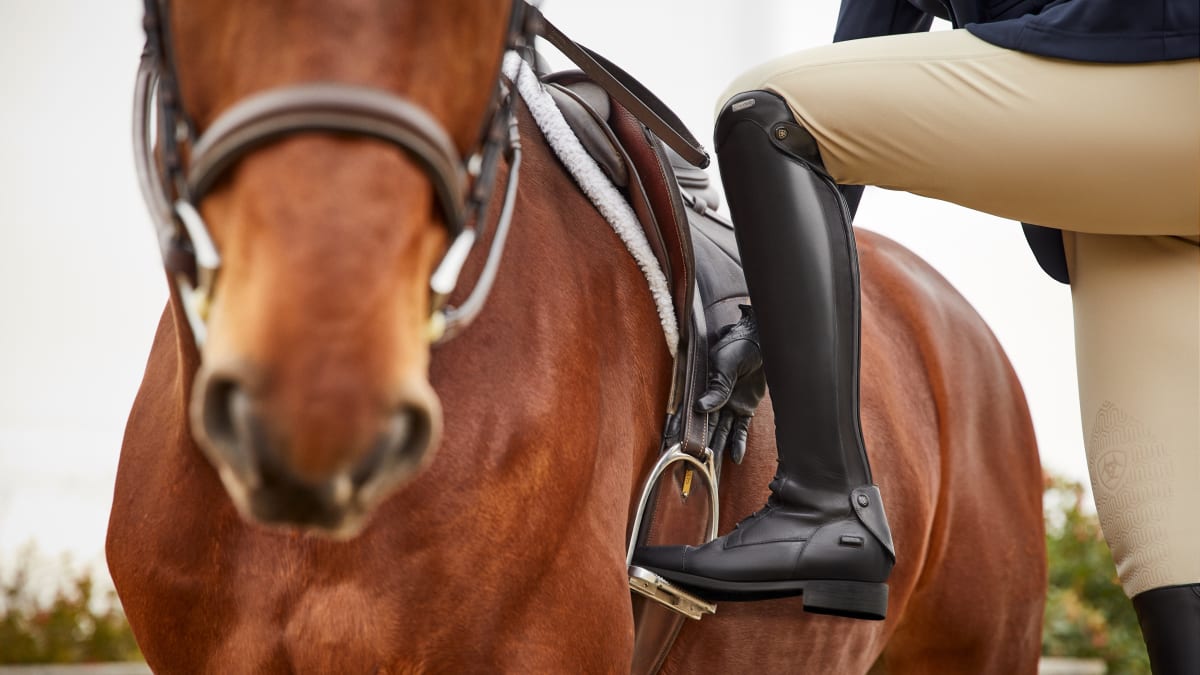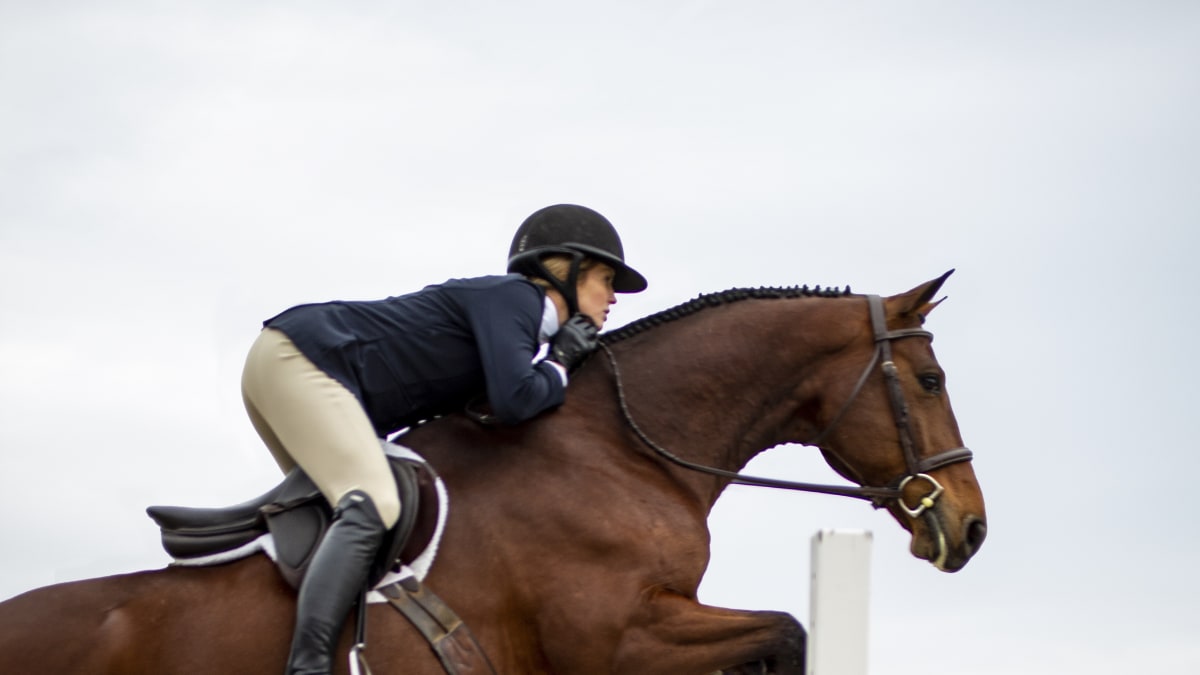
What Are the Different Types of English Horseback Riding?
Although English and Western horseback riding have many similarities, it only requires a glance at what a rider is wearing to know which style they practice. Learn more below.
English riders are distinguished by their attire and unique English disciplines. Many English events and styles use a close contact saddle, also known as a jumping saddle. Understanding the history and basic types of English riding helps you to appreciate this fascinating equestrian style.
English Riding Styles Explained
Equestrian disciplines are diverse, but there are similarities across each type of English riding. You can easily distinguish an English rider by their English riding apparel. English riders typically dress in form-fitting jodhpurs (sometimes called “jods”) or riding breeches with leather tall riding boots or paddock boots with half chaps (whereas many Western riders wear jeans and cowboy boots).
In addition to show clothing and boots, English-style riders utilize a sleek and slight saddle, cut in close contact with the horse. English saddles do not have a horn on the pommel, or front of the saddle. There are almost as many types of English saddles as there are types of English riding.
Although English riding includes many disciplines, including classical dressage, polo and saddle seat, there are three English riding disciplines recognized in the Olympic Games today: dressage, show jumping and eventing.
Polo, though commonly confused as an Olympic sport, last appeared in the games in 1936. Two other styles—saddle seat and English pleasure riding—aren’t currently in the Olympics but represent some of the most traditional styles of English horseback riding.
Read on to better understand the common English riding disciplines.
Dressage
Equal parts art and skill, dressage is a classical English discipline that’s focused on the connection between horse and rider. When you think of big imported Warmblood horses “dancing,” that’s dressage. The French name literally translates to “training,” and it’s used to describe both the method of schooling horses, as well as the competitive sport -- which is why you may also see Western riders performing dressage.
A central theme in dressage is the focus on harmony between horse and rider. A successful dressage rider and horse are in sync with each other. The pair should demonstrate good quality of movement and acceptance of the rider’s aids. The horse appears content and enjoys his job, and the rider is quiet in their body position and cues.
Dressage is a sport that’s ridden on the flat, usually in a ring of a set, standardized size. Competitors within the same division all complete the same test, made up of a series of movements carried out in a fluid pattern. Pairs earn a score from the judge that’s based on percent completion for each designated movement.
A captivating variation on the classical sport, freestyle dressage is dressage that’s ridden to a musical soundtrack. Incorporating music adds elements of rhythm, and riders must demonstrate additional skills within their tests.

Hunter/Jumper Riding
A fantastic spectator sport, the term hunter/jumper encompasses three separate disciplines: hunters, jumpers (or show jumping) and equitation.
The hunter sport evolved to identify horses that would be successful in a fox hunt. An ideal hunter horse is quiet and consistent, and Hunter Over Fences classes are primarily concerned with the horses’ ability to move through a course with a consistent, rhythmic pace with quality movements and a pleasant attitude (ears forward, head carriage centered). Fences are built to replicate obstacles found in nature including hedges, brush and stonewalls among others.
Jumpers are a sport concerned with speed. Also called show jumping, jumpers attempt to clear a course within a set window of time. Competitors that exceed the set time or knock down rails accrue faults that are added to their score.
Equitation refers to the position and effect of the rider, rather than the horse. Equitation can be judged on the flat or over fences, taking into account the rider’s form, correctness and effect of the aids. It can include the appearance, or turnout, of the horse and can be found in other disciplines, such as Western equitation and saddle seat equitation.

Eventing
Often thought of as an equestrian triathlon, three-day eventing is a diverse and action-packed sport that combines three individual phases: dressage, show jumping and cross-country riding. Eventing grew out of the fox hunting tradition in England before developing as a military test of a mounted officer’s equestrian skill. Modern evening competitions often unfold across three or four days, though one-day and two-day formats are not uncommon.
Dressage is always the first phase of the sport, followed by show jumping or cross country. Unlike traditional dressage, the lowest score leads in eventing dressage, with combinations adding faults to their score in each proceeding phase of competition for a rail or a refusal (four points in show jumping, twenty in cross country).
Eventing is most recognized for the endurance test of the cross-country phase. Horse and rider complete a timed course, featuring elements like coops, tables and hanging logs, plus water complexes, ditches, banks and mounds. Unlike show jumping, cross country fences are fixed and solid, meaning they do not have a rail that falls if the horse knocks the fence. Elimination occurs for a variety of reasons—most often for rider or horse falls, maximum refusals or technical reasons like jumping fences out of sequence.
Saddle Seat and English Pleasure
Saddle seat is distinguishable by the high-stepping movements of its energetic gaited horses. The horses used in this riding discipline often have short necks with long, flowing manes and a smooth, animated stride. Horse and rider combinations are judged on the flashy nature and fluidity of the horse's movement and the position and balance of the rider.
English pleasure refers to both recreational flat riding, also called “hacking,” as well as competitive English pleasure classes judging the horse’s gaits on the flat at the walk, trot and canter. This type of riding has practical roots, originating as a means of travel across the English countryside.
Saddle seat riding also originated in Europe, where high-stepping horses were paraded in parks, and in the American South, where plantation owners and overseers prized the smooth gait of the Saddlebred horse during travel field-to-field. Breeds commonly exhibited in saddle seat style include Arabians, Morgans and Tennessee Walking Horses.
Polo
Polo is one of the oldest team sports in the world. Two teams of four mounted riders play on a grass field. Riders are armed with long mallets and attempt to drive a small ball into the opposing team’s goal. The game lasts for at least four “chukkas,” or plays, and the team with the most goals at the end wins. Polo games are full of fast-paced action and riders usually ride several horses throughout the game. Polo ponies are generally spirited, small and athletic.
English riding disciplines are as diverse as the horses and riders that participate in these historic riding styles. A dressage rider and a polo player engage in wildly different activities, but their sports share a common history and tradition.




